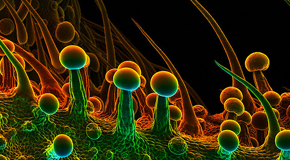FIBER ANALYSIS


Fibers can be classified into two broad categories – natural and man-made. Natural fibers are derived from animal, vegetable or mineral sources. Animal fibers include furs, wool, silk, horsehair, and animal hairbrushes. Vegetable fibers include cotton, linen, jute, hemp, and sisal. Many ropes, clothes, paper, and packing materials are made from vegetable fibers. Mineral fibers include asbestos, glass wool, and fiberglass. Products such as insulation, auto body repairs, clothing, drapery, insulation, and fire proofing are produced from mineral fibers. By far, the most commonly encountered natural fiber is cotton. However, due to the commonality of white and blue denim fibers produced from cotton, cotton fibers of these colors have little evidentiary value.
Regenerated fibers are a type of man-made fiber manufactured from natural raw materials in which pure cellulose is extracted and chemically treated. This type of fiber includes rayon, acetate, and triacetate fibers. Synthetic fibers are produced solely from synthetic polymers. These include nylon, polyester, and acrylic fibers. These fibers can be found in clothes, drapery, bindings, fishing lines, and hosiery.
Laboratory examination of fibers is principally performed using a polarizing light microscope. Using this instrument and oils of known refractive indices, a scientist can examine and compare color, thickness, cross sectional shape, amount of delusterant and composition. Other instrumental techniques, such as FTIR, are commonly used to determine synthetic fiber composition. UV-VIS microspectrophotometry can be used to discriminate color in the ultraviolet and visible regions that cannot be discerned visibly. Analysis of dyes present in fibers can also be performed.
As is the case with glass and paint, a positive association in forensic fiber analyses is usually not a conclusive identification. A positive association will typically result in a conclusion that a questioned fiber is consistent with a known fabric. The importance of this finding may be directly related to how rare or how common the specimens may be, in terms of availability. Again, no statistical data is typically applied to this type of conclusion.
Other types of fiber examinations commonly conducted are physical matches of torn fabric and the examination of fabric impressions formed when a fabric contacts a hard surface. An example of this type of impression is a corduroy impression from the victim’s pants left in the paint of a suspect vehicle in a hit and run incident.
Our analytical scheme for fiber analysis and comparison varies depending on fiber type and sample size. This scheme may include polarized light microscopy, micro-FTIR, visible microspectrophotometry and pyrolysis gas chromatography-mass spectrometry.

